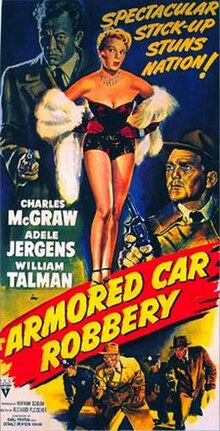|
Armored Car Robbery
Armored Car Robbery is a 1950 American film noir starring Charles McGraw, Adele Jergens, and William Talman.[2] Directed by Richard Fleischer, Armored Car Robbery is a heist movie, which tells the story of a well-planned robbery of cash from an armored car when it stops at a sports stadium. The theft goes awry and a tough Los Angeles cop sets off in determined pursuit of the culprits. PlotIn Los Angeles criminal mastermind Dave Purvis devises a scheme to rob an armored car on its last pickup of the day. He recruits scuffling Benny McBride, who brings in fellow low-level professional crooks Al Mapes and Ace Foster to complete the gang. Benny needs money to feed his hopeless plan to win his wife Yvonne back, a gorgeous blonde stripteaser who lost interest in him and is seeing another man. Unbeknownst to him, it is Purvis. The robbery at minor league Wrigley Field begins as planned but goes wrong when a passing police patrol car intervenes. Purvis kills one of its officers and the gang makes its getaway. Lt. Jim Cordell, the dead cop’s partner, takes it upon himself to bring the killer to justice, and throws himself into the case, brusquely treating rookie replacement Danny Ryan. In the hail of gunfire Benny was badly wounded. Having switched to another getaway car, the four luckily pass a roadblock. When McBride demands medical attention - and his share of the loot - he’s shot dead by Purvis. Mapes sows dissent when Purvis insists he’s going to give Benny’s cut to his widow, correctly deducing they’re a thing. Foster disposes of the second getaway car carrying McBride's body in the harbor. He is then killed by the police as the three attempt to escape in a motor boat. Mapes and Purvis get away separately, with Purvis still holding all the loot. Mapes tries to meet Yvonne at the burlesque where she works, seeking a lead on Purvis. The waiting police intercept and arrest him, and learn Purvis' identity. Ryan goes undercover disguised as Mapes, whom Yvonne has never met. Purvis alerts her, and captures Ryan; he is shot and severely wounded while attempting to flee, but manages to inform Lt. Cordell that Purvis and Yvonne are intending to leave the country by chartered airplane from Los Angeles Metropolitan Airport. Lt. Cordell and his team corner the couple there. Purvis is run over by a landing plane as he tries to escape across the runway. The money is recovered. As Ryan heals from his wound he is accepted by Cordell as a worthy partner. Cast
ProductionThe film was based on a story by Charles Pete and Richard Carroll about a $500,000 robbery, based on a 1934 robbery at Rubel Ice Company. Originally called Gravesend Bay it was sold to RKO in March 1949. Robert Ryan was meant to play the rookie cop.[3][4] The studio retitled it Code No 3.[5] In August 1949 Earl Felton was assigned to write the script. Herman Schlom was producer and Richard Fleischer was to direct.[5] Charles McGraw was cast in December 1949.[6] The film was filmed on location in Los Angeles, California over 16 days. Locations include Wrigley Field and the Metropolitan Airport.[7] ReceptionCritical responseVariety magazine gave the film a mixed review, calling it an okay film, and wrote, "RKO has concocted an okay cops-and-robbers melodrama ...[and] McGraw, Don McGuire and James Flavin, as cops, do very well. Talman and his cohorts put plenty of color into their heavy assignments. Adele Jergens attracts as a stripteaser and Talman's romantic interest".[8] Time Out Film Guide review[when?] lauded the film and called it "a model of its time". They wrote, "Almost documentary in its account of the heist that goes wrong and the police procedures that are set in motion, making excellent use of LA locations, it relies on superb high contrast lighting to meld reality into the characteristic noir look".[9] According to American studies and film professor, Bob Porfirio, Armored Car Robbery possesses the "film noir visual style" of the many RKO crime and suspense films of the early 1950s, such as: high-contrast photography integrating studio and location shooting, expressionistic lighting, deep focus, and haunting music (by Roy Webb).[10] Film critic Roger Fristoe believed director Richard Fleischer pushed the boundaries of the Motion Picture Production Code. One edict was, "Methods of crime shall not be explicitly presented or detailed in a manner calculated to...inspire imitation." Armored Car Robbery, however, had a blunt title, explicit violence and a detailed account of the planning and execution of the crime. As such, even though the criminals are caught, Armored Car Robbery tested the waters and helped set the stage for other films noir and heist films like The Killing (1956), which shares some similarities.[11] Home mediaWarner Bros. released the film on DVD on July 13, 2010, in its Film Noir Classic Collection, Vol. 5.[12] Has been shown on the Turner Classic Movies show 'Noir Alley' with Eddie Muller. References
External links
|
||||||||||||||||||||||||||||||||
